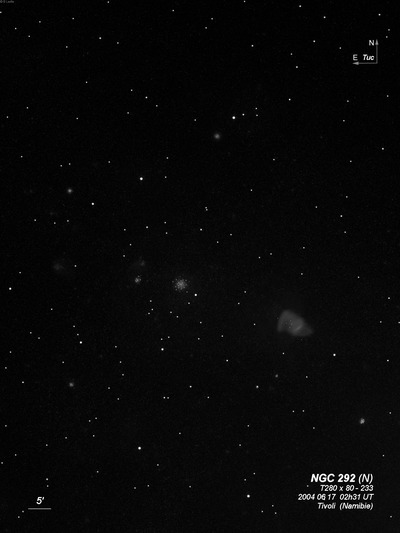Small Magellanic Cloud
Small Magellanic Cloud

Amerigo Vespucci was the first northern hemisphere explorer to see the SMC in 1501, 20 years earlier than Magellan. This was mentioned in a 1990 article by Dekker.
John Herschel (h2356) has two entries: "I should consider this to be about the main body of the Nubecula Minor, which is here fairly resolved into excessively minute stars, which are however certainly seen with the left eye." On a later sweep he noted: "Hereabouts seems to be placed the main body of the Nubecula Minor which is a Faint, Rich, Large Cluster of very small stars (12..18) filling many fields, and broken up into many knots, groups, and straggling branches. But the whole is clearly resolved into stars."
Pietro Baracchi observed the region between NGC 220 and NGC 294 over 16 and 17 Dec 1887 using the 48" Melbourne telescope. Along with discovering a few new objects that went uncredited (Bruck 67 near NGC 294, Kron 25, SMC-N45), he wrote "About this region there is a very large cluster of stars scattered in an irregular way - from 12 to 18. This covers more than one field ..with the supposed [GC 166 = NGC 294], there are other small groups surrounded by extremely faint nebulosity; and along this space occupied by the objects from A NGC 220] to N NGC 294] there are several stars which seem to be nebulous. All the region along with these objects the sky is almost continuously covered with a multitude of stars, which render the observations difficult and confusing."
400/500mm - 18" (7/6/02 - 7/10/02 - Magellan Observatory): During a week's stay I went through the most prominent clusters and nebulae in the SMC using the fork-mounted 18" at Zane Hammond's observatory.
Naked-eye - (6/29/02 - Bargo): this number refers to the entire SMC. My first view of the SMC was outside Sydney with Les Dalrymple. I only took observing notes (through a 12") on SMC globular NGC 121 and nearby cluster Kron 3, as well as 47 Tucanae.
Notes by Steve Gottlieb